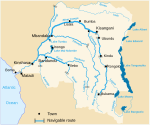Aruwimi River: Difference between revisions
iw |
mNo edit summary |
||
| Line 37: | Line 37: | ||
[[fr:Aruwimi]] |
[[fr:Aruwimi]] |
||
[[sw:Aruwimi]] |
[[sw:Aruwimi]] |
||
[[sv: |
[[sv:Aruwimifloden]] |
||
[[lt:Aruvimis]] |
[[lt:Aruvimis]] |
||
[[hu:Aruwimi]] |
[[hu:Aruwimi]] |
||
Revision as of 11:26, 12 May 2010

The Aruwimi River is a tributary of the Congo River, located to the north and east of the Congo.
The Aruwimi begins as the Ituri River, which arises in the savannas north of the Kibale River watershed. It then runs generally south southwest until it is joined by the Shari River which flows by Bunia. The Ituri then turns west, through the fabled Ituri Forest, becoming the Aruwimi where the Nepoko (or Nepoki) River joins it, at the town of Bomili. The river continues westward, joining the Congo at Basoko, for a total length of about 1,300 km (800 mi). It is about 1.5 km wide where it joins the Congo.
The watershed of the Ituri/Aruwimi is almost entirely dense forest, with just a handful of villages along its course, and crossed by roads in about four places. The Kango language (SIL code KZY) is spoken by several thousand villagers just south of Avakubi, and upper reaches of the Ituri are inhabited by the Mbuti (Pygmies).
The Aruwimi was explored by Henry Morton Stanley during his 1887 expedition to "rescue" Emin Pasha. The cataracts above Yambuya made it impossible to use the river for navigation, and the expedition had to go by land, with tremendous difficulty.
Tributaries:
- Nepoko
- Lenda
Settlements:

